Anxiety is a tricky beast. On the one hand, anxiety protects us from real danger and motivates us to take important actions. On the other hand, anxiety can be mentally, emotionally, and physically excruciating and not overly eager to go away.
You may feel like you have tried absolutely everything you could think of to ease your anxiety. Surprisingly, the things that you are doing to try to get rid of your anxiety are quite possibly what is keeping your anxiety around! Keep reading to learn about the cycle of anxiety and see what I mean.
Table of Contents
What Is Anxiety?
As you might already know, what you perceive as anxiety is essentially your fight or flight response kicking in. In a dangerous situation, your fight or flight response is designed to keep you safe. If a tiger comes charging towards you in the jungle (eek!), your fight or flight response kicks in so that your body is better prepared to run away or fight back. The problem is when your brain starts having a similar response to things like meeting someone new or driving to the store. Your brain is trying to protect you from something it believes to be dangerous, however, in this case it’s not particularly helpful.
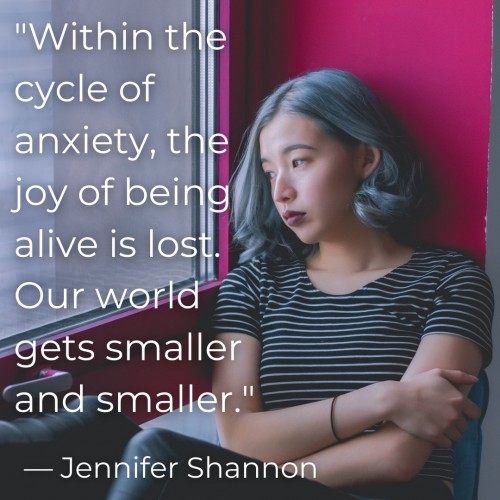
The Cycle of Anxiety
Anxiety doesn’t usually come from nowhere. Sometimes it comes from a specific experience or sometimes it is built up over time. You can think of problematic anxiety as a cycle that reinforces itself:
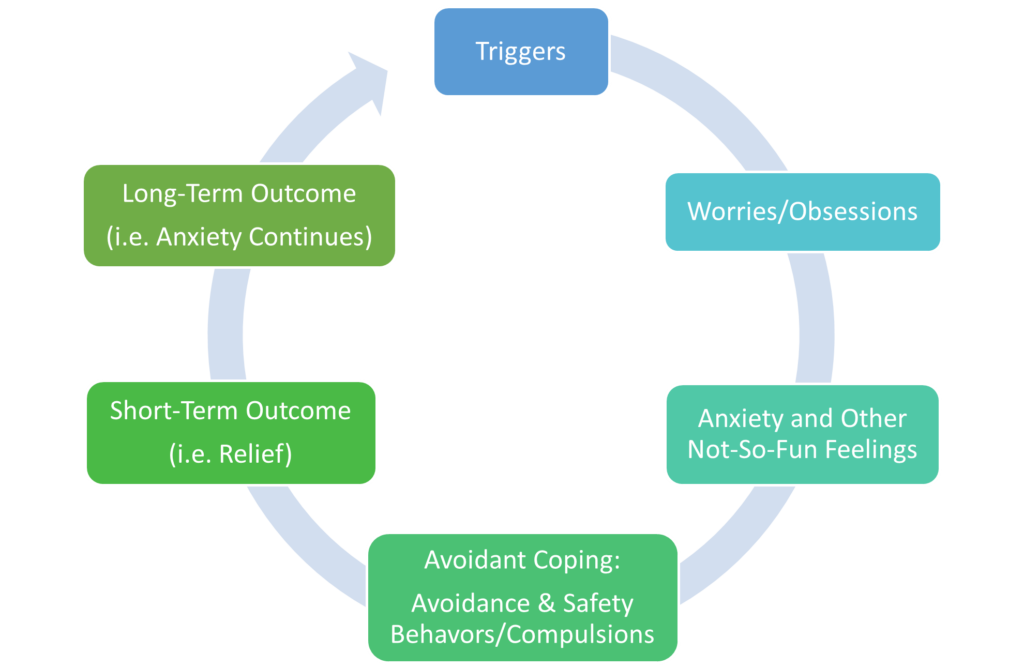
Let’s talk about each of these stages.
Triggers
The first stage in the cycle of anxiety is an anxiety trigger. A trigger is anything that your brain has re-labeled as “dangerous,” and therefore responds to with the fight-or-flight response. A trigger can be literally anything (a place, an activity, an object, a thought, a sensation, etc.).
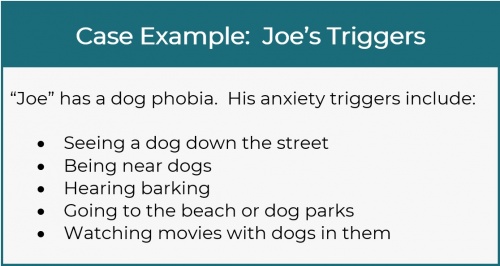
Worries or Obsessions
Triggers are usually followed by lots of “What if…?” type thoughts. For example:
- What if my boss fires me?
- What if I fall out of the rollercoaster?
- What if I make a fool of myself?
- What if I accidentally hurt someone?
These types of thoughts may be referred to as obsessions (the “O” in OCD) or worry thoughts. Obsessions and worry thoughts are based on a sense of uncertainty, typically about something that feels very important in the moment.
Some worries may be somewhat logical, such as “What if I get in a car accident?” (which is always a possibility when you drive). Others may be illogical, such as “What if I get lung cancer from touching that door handle?” Since anxiety is not coming from the logic part of your brain, however, the degree to which the thought “makes sense” doesn’t really matter. You may be well aware that your thoughts either don’t make sense or are exaggerated, but that doesn’t help you to feel any less scared in the moment.
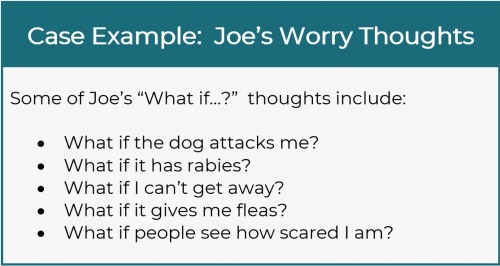
Anxiety and Other Not-So-Fun Feelings
All these worry thoughts can lead to feeling anxious, nervous, scared, panicked, overwhelmed, or all of the above. You may feel sad about how anxiety is getting in your way or affecting your life. You may feel angry – at yourself, at others, or at your anxiety. You may feel embarrassed or ashamed of what you are dealing with (I often work with individuals who are). While these are all very human emotions that we all feel at some point in our lives, most people don’t like feeling this way if they can help it. That’s where the next stage in the cycle of anxiety comes in.
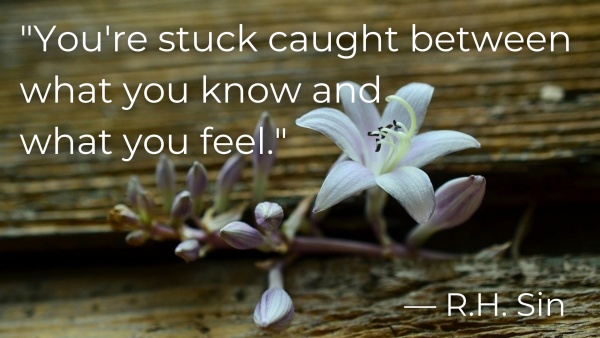
Avoidant Coping
In this stage, you will usually do whatever you can to prevent or quickly get rid of your anxiety (and other no-so-fun feelings). Usually this falls into one of two categories: avoidance or safety behaviors/compulsions (the “C” in OCD).
Avoidance
With avoidance, you will do everything you can to avoid your triggers in the first place. You may stop going to certain places, spending time with certain people, watching certain types of shows or movies, engaging in certain activities, touching certain objects, talking about certain topics, etc.

Safety Behaviors or Compulsions
These are actions taken to reduce or temporarily get rid of your anxiety when avoidance is not possible or highly inconvenient. Common types of safety behaviors and compulsions include:
- Checking (ex: checking that something is safe, that nothing bad happened, that a mistake wasn’t made, etc.)
- Cleaning (ex: washing your hands, using hand sanitizer, wiping down surfaces, etc.)
- Researching (ex: looking up potential risk factors or warning signs, finding solutions, etc.)
- Fidgeting (ex: leg bouncing, hair twirling, nail biting, pacing, etc.)
- Repeating (ex: re-reading, re-writing, re-ordering, etc.)
- Reassurance seeking (ex: asking loved ones for reassurance that nothing bad will/did happen)
- Distraction (ex: watching TV, scrolling through social media, online shopping, etc.)
- Safety objects (ex: always carrying around pepper spray, hand sanitizer, a barf bag, etc.)
- Mental compulsions (ex: reviewing events that already occurred, excessively planning for upcoming events, rationalizing why you “shouldn’t” be afraid of something, repeatedly praying, trying to neutralize a “bad” thought with a “good” one, ruminating on all the possible worst-case scenarios, trying to endlessly figure something out, etc.)
This is by no means an exhaustive list. Some important notes about safety behaviors/compulsions:
- Things that can be a compulsion or safety behavior may not always be one. For example:
- Someone may re-read because they have ADHD and it’s difficult for them to focus, or they may re-read because they are worried that they may not have fully understood the material the first time they read it.
- Someone may pray for spiritual reasons, or they may pray to try and gain certainty that nothing bad will happen.
- The motivation behind the action (i.e. minimizing or getting rid of anxiety) is what makes the action a compulsion/safety behavior.
- Safety behaviors/compulsions are not always consistent and can change over time.

The Short-Term Outcome
In the short-term, avoidance and compulsions/safety behaviors are usually at least somewhat effective. They can provide you with a sense of relief from all the anxiety and other not-so-fun feelings that come up in response to your triggers.
Avoidance and safety behaviors can help you feel like you have more certainty about something that feels very uncertain. Or they can help you feel like you have more control over a situation that feels very out of your control.
And this is why you do these things in the first place—they work! If you’re worried about getting sick and so you wash your hands, you feel more certain that you won’t get sick. If you’re worried that you might fall out of the roller coaster, you may check your safety harness repeatedly to reassure yourself that you are securely buckled in. In both these situations, the compulsion/safety behavior has (at least temporarily) reduced your anxiety.
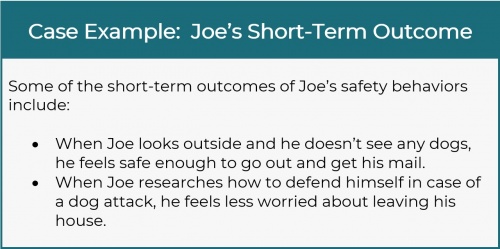
The Long-Term Outcome
The kicker is what happens to your anxiety in the long-term when you consistently engage in avoidance or compulsions/safety behaviors. All of that avoidance tells the fear part of your brain that there must be something to be scared of, otherwise you wouldn’t need to avoid it! All of those compulsions/safety behaviors tell your brain that something bad will happen unless you keep doing them (otherwise, why would you keep doing them?).
This is the tricky thing about anxiety: the very actions that help you to get some relief in the short-term, are the ones that are keeping your cycle of anxiety going in the long-term.
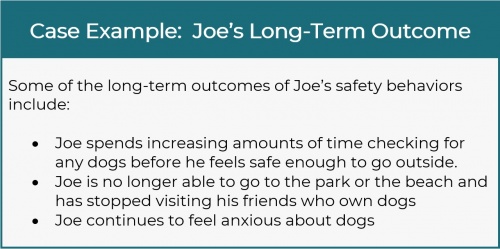
So Now What?
So now that you know what’s actually keeping your anxiety around, you might be wondering how to break this cycle. You can start to by looking for the patterns in your own anxiety. Below is a worksheet you can fill out to get you started.
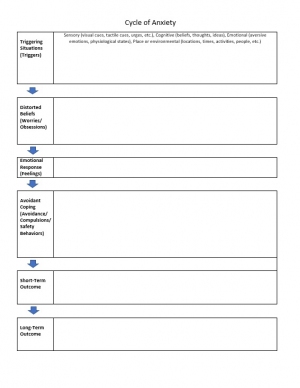
If you’re able, the next step is to gradually begin to avoid less or do fewer safety behaviors/compulsions. The more you’re able to face your triggers without doing any sort of avoidance or safety behaviors, the weaker your anxiety will become over time.
That’s not to say that this is an easy process. If it was easy, you probably would have just done it already! Which is why many people get stuck in the cycle of anxiety to begin with.
The formal name for this method in therapy is Exposure and Response Prevention (or ERP). ERP involves gradually exposing yourself to things that trigger your anxiety and then preventing your usual response of either avoiding or doing compulsions/safety behaviors.
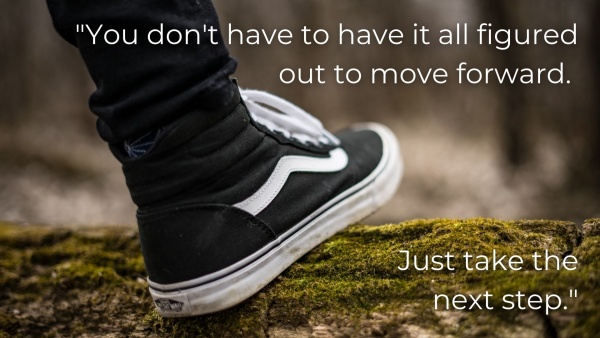
I hope that this article has been helpful for you if you are trying to figure out what keeps your own anxiety going. If you are interested in learning more about ERP as a treatment, keep an eye out for my next article!
As a reminder, this blog post is not intended as professional counseling or clinical advice. This article is meant to provide you with a better understanding of your cycle of anxiety. However, I encourage you to consider seeking help in person if you need additional support or are feeling overwhelmed by your anxiety or OCD.

-Kristel Roper, LMFT, LPCC
Kristel Roper is a licensed psychotherapist offering therapy services to individuals in the Sacramento area. She specializes in anxiety counseling and especially enjoys working with young adults as they navigate the challenges of college, career, and beyond. Learn more about Kristel Roper’s Therapy Services.
Photo by congerdesign from Pixabay
Photo by mikoto.raw Photographer from Pexels
Photo by Jeffrey Wegrzyn on Unsplash

Greetings! Very helpful advice within this post! It is the little changes that will make the most significant changes. Thanks for sharing!
Right here is the perfect blog for anyone who hopes to understand this topic. You understand so much its almost tough to argue with you (not that I personally will need toÖHaHa). You certainly put a fresh spin on a topic that has been written about for a long time. Wonderful stuff, just excellent!
Everything is very open with a really clear description of the challenges. It was definitely informative. Your site is very helpful. Many thanks for sharing!